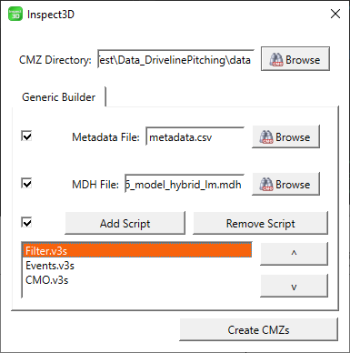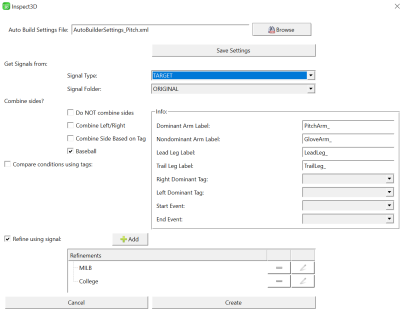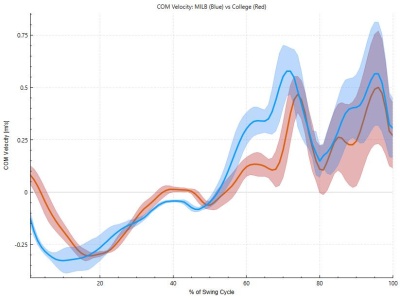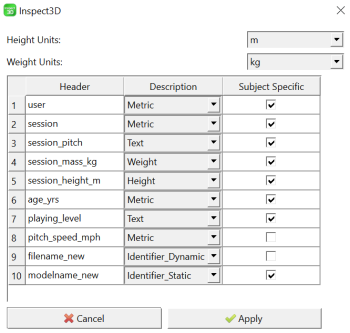Inspect3D Tutorial: Build CMZs
| Language: | English • français • italiano • português • español |
|---|
Through the OpenBiomechanics Project, Driveline Baseball has made elite-level motion capture data publicly available. The data can be downloaded from Driveline's GitHub repository.
Having access to large datasets is a great asset, but processing these large datasets can take time (and patience). Inspect3D is designed to streamline this process. The steps in this tutorial describe how to create CMZ files from the pitching and batting data sets, then inspect and group the data in Inspect3D.
Downloads and Relevant Links
To follow along with this tutorial, ensure that your version of Inspect3D is at least v2023.08.08. Earlier versions will not have the Build CMZ feature. After verifying that you have the correct version of Inspect3D, download the following two zip files.
Please note, these downloads contain a large amount of data. Building CMZs is a slow process, so if you want to speed it up to follow along with this tutorial cut the number of datasets under openbiomechanics-main down to 3-5 subjects.
For more technical information on the Build CMZ feature, see: Build CMZs Documentation
Build CMZs for Pitching Data

In the Build CMZ Dialog:
- Set the CMZ Directory to: C:\...\openbiomechanics-main\baseball_pitching\data\c3d
- Set the Metadata to: C:\...\openbiomechanics-main\baseball_pitching\data\metadata.csv
- Set the MDH File to: C:\...\openbiomechanics-main\baseball_pitching\code\v3d\model\v6_model_hybrid_lm.mdh
- Add the following scripts and ensure they are in the correct order:
- C:\...\CMotion Files\Filter.v3s
- C:\...\CMotion Files\Events.v3s
- C:\...\openbiomechanics-main\baseball_pitching\code\v3d\CMO.v3s
- Click Create CMZs
- A metadata dialog box will appear. Ensure the "Subject_Specific" next to "playing_level" is checked and click "Apply".
- CMZ files may take a while to build. Check the status bar in the bottom left hand corner of the interface for the build status. After the files are built, check that the Library Path dialog is set correctly and hit "Load" in the Load Library dialog.
Query and Inspect Pitching Data

After building CMZs you will need to query your data before you can inspect it. Start by opening the Query Builder dialog and navigating to the Auto-Populate Query menu. Browse for an Auto Build Settings File and populate this field with the AutoBuilderSettings_Pitch.xml file found under the c-motion specific files zip folder you downloaded earlier. The dialog should auto-populate with the query refinements.
Click Create, select the groups you want to query, and hit "Calculate Selected Queries".
You should now be able to inspect the data you loaded. An example from this data set is shown to the right.

Further Reading
To recap: this tutorial has demonstrated how Inspect3D can be used to streamline the processing of large data sets. It can:
- automatically combine static, dynamic and MDH files into CMZs
- automatically apply metadata to data sets
- automatically apply refinements to data sets
- visualize and display the refined data
For examples of how to create and manage metadata files, see: Refining Queries with Metadata Tutorial
